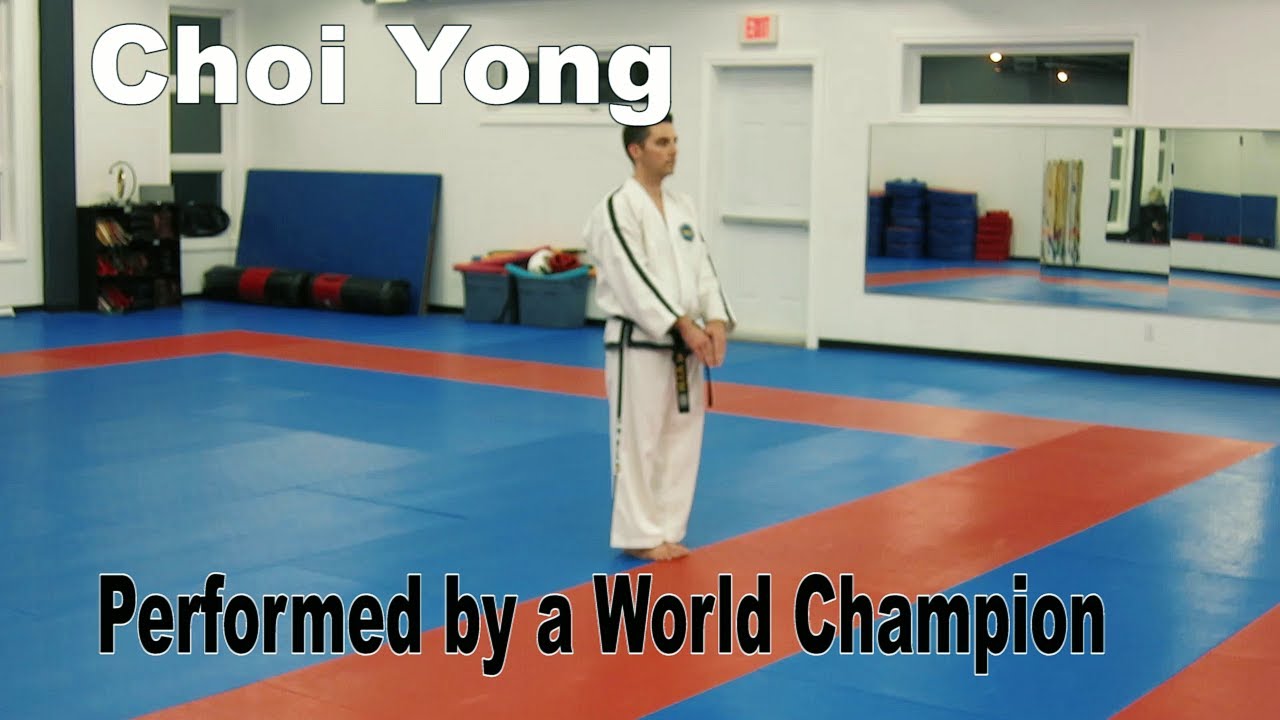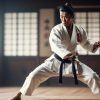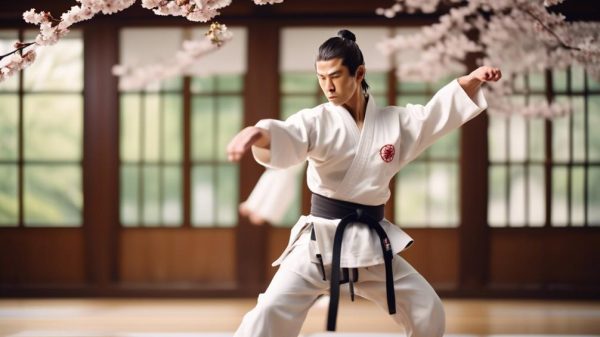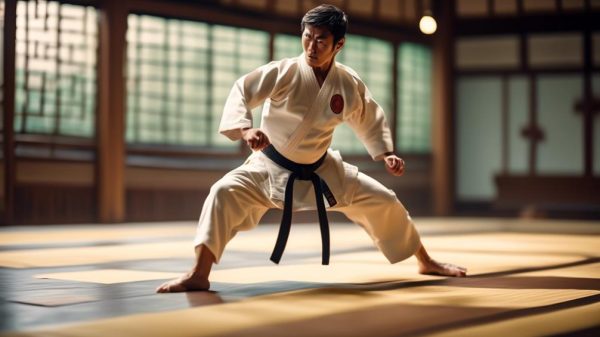The taekwondo pattern Choi-Yong means “justice and courage” in Korean. Training this form embodies those key virtues by developing mental and physical discipline.
Practicing the 35 ordered motions of Choi-Yong builds coordination, balance, flexibility, and power. Students visualize defending against attacks as they block, kick, strike, and punch.
Proper technique and control takes precedence over speed and athletic ability. Repeating Choi-Yong ingrains stances, angles, and transitions into muscle memory through good form rather than strain.
The even pace with explosive intermittent techniques boosts endurance. The symmetry between sides helps concentration and confidence to execute combinations fluidly under pressure.
Mastering Choi-Yong instills thevalues of justice with ethical techniques and courage to defend just causes with skill as a way of taekwondo life. The name and lessons of this pattern reflect each other.
Key Takeaways
- The meaning of “justice and courage” conveys core Taekwondo tenets – ethical conduct takes courage, courage requires acting justly. The name suits the lessons.
- Developing precision and control has more importance than athletic aptitudes or competition when training this form. Focusing on technique refinements matters most.
- Repetition ingrains proper stances, correct striking angles, transitions between motions, and weapon hand positions through good form rather than strain.
- The symmetrical movements between right and left sides enforce concentrated practice on balance, stance stability, and breathing coordination with technique execution.
- Explosive intermittent attacks struck after slower stretches boosts explosive power and dynamic endurance essential in Taekwondo.
- Visualizing defending against assaults while flowing smoothly between blocking and counter-attacking enhances reality-based mental preparedness.
- Progress requires patience as mastery means movements become fluid reactions requiring little thought, making the body move the way the mind intends.
History of Choi Yong Form
The origins of the Choi Yong form are deeply rooted in the long history of Taekwondo. This form, named after General Choi Yong, a prominent figure in Korean martial arts and a military leader during the Koryo dynasty, embodies the spirit and principles of traditional Taekwondo.
The movements and techniques of this form reflect General Choi Yong’s influence and legacy, showcasing the discipline and strength of ancient martial arts traditions.
The history of the Choi Yong form acts as a bridge that connects present-day practitioners to the timeless customs and values of Taekwondo. Throughout history, this form has evolved, demonstrating the resilience and adaptability of the martial art as it has flourished through generations.
Understanding the historical context of the Choi Yong form not only enhances your practice but also fosters a deep appreciation for the cultural heritage from which Taekwondo emerged.
Techniques and Movements
Taekwondo America Form Choi-Yong incorporates a wide range of dynamic kicks, punches, strikes, blocks, and stances to create fluid and powerful sequences. To better understand the various techniques and movements in this form, refer to the table below:
| Techniques | Movements |
|---|---|
| Front Kick | Forward, snapping motion |
| Side Kick | Lateral, explosive thrust |
| Roundhouse Kick | Circular, powerful strike |
| Punches | Straight, quick strikes |
| Strikes | Various hand and foot strikes |
| Blocks | Defensive techniques |
| Defensive Maneuvers | Redirecting opponent’s attacks |
| Stances | Balanced, stable positions |
Each technique and movement requires precise execution and dedicated practice to master. Regular practice, focused execution, and guidance from experienced instructors are crucial to perfecting these techniques.
Additionally, visualizing each movement and breaking down the form into smaller parts can aid in understanding and mastering Taekwondo America Form Choi-Yong.
As you continue to practice and improve, you will enhance your flexibility, agility, cardiovascular endurance, mental discipline, focus, strength, and coordination, demonstrating your progress and skill level as a martial artist.
Meaning and Symbolism
Uncover the symbolism behind the movements in the Choi-Yong form and learn about its historical significance and cultural influences.
Gain insight into how each movement represents the virtues and strategic prowess of General Choi Yong, providing a deeper understanding of the form’s profound meaning.
Explore the symbolic elements and discover the rich historical and cultural tapestry that has contributed to the development of this impactful Taekwondo form.
Symbolic Movements in Form
Symbolically integrated into the Choi-Yong form are movements that embody the noble qualities of a martial artist, reflecting loyalty, duty, and honor. When performing this black belt form in Taekwondo America, each movement carries deep symbolism, representing your journey through discipline, perseverance, and self-improvement.
The techniques incorporated in this form symbolize your understanding of balance and harmony, fundamental concepts in Taekwondo philosophy. The sequence of movements in Choi-Yong form demonstrates your ability to adapt and flow, symbolizing your agility and mental flexibility.
Additionally, the form’s patterns and transitions represent your growth, from foundational techniques to advanced skills, reflecting your progress in Taekwondo training.
Historical Significance of Form
Honoring the historical significance of the Choi-Yong form in Taekwondo America, its meaning and symbolism embody the essence of military discipline and strategic prowess. This form, used by black belt practitioners in Taekwondo, pays tribute to General Choi Yong’s influential role in the development of this martial art.
Each movement within the form reflects the values of loyalty, courage, and leadership associated with General Choi Yong’s contributions to Taekwondo. By mastering the Choi-Yong form, practitioners pay homage to the enduring impact of General Choi Yong on the development of Taekwondo and the martial arts lineage.
This form symbolizes the rich history and tradition of Taekwondo, ensuring that the legacy of General Choi Yong is respected and preserved. Through practicing and mastering this form, students show their respect for the historical significance and lasting legacy of Taekwondo.
Cultural Influences on Form
The Choi-Yong form in Taekwondo America holds great historical significance. Exploring its cultural influences can provide valuable insights into the rich heritage and traditional values that shape its meaning and symbolism.
By understanding these cultural influences, practitioners can deepen their connection to Taekwondo’s history, values, and traditions. The form embodies respect, discipline, and honor, reflecting the traditional Korean values.
Its movements and sequences may incorporate elements from Korean culture, mythology, or historical martial arts traditions. Acquiring knowledge about these influences can enhance practitioners’ understanding of Taekwondo as a holistic discipline and further their mastery of the black belt form.
Training and Practice Tips
Regularly training and practicing Taekwondo America Form Choi-Yong is crucial for mastering its intricate movements and techniques. To effectively learn and perfect this form, it’s recommended to break it down into smaller sections. By focusing on one section at a time, you can better understand the nuances of each movement and execute them with precision.
It’s important to prioritize correct execution over speed initially to ensure flawless technique. Seeking guidance from experienced Taekwondo instructors is highly recommended to receive feedback on your form and make necessary corrections.
Visualization can be a powerful tool for improving muscle memory and form. Therefore, it’s beneficial to visualize each movement in your mind before physically practicing it. This will help you understand the mechanics of the form and perform it more accurately.
Consistent and deliberate practice, along with attention to detail, will lead to mastery of Taekwondo America Form Choi-Yong. By dedicating yourself to refining your form, you’ll progress towards achieving excellence in this martial art.
Importance in Taekwondo
Mastering the Choi-Yong form in Taekwondo America is vital for the development of advanced skills, building confidence, and achieving higher belt ranks and leadership roles within the organization. This form holds great significance in Taekwondo for several reasons:
- Showcasing Advanced Skills & Techniques
- Progressing to Higher Belt Ranks & Leadership Roles
- Emphasizing Precision, Power, & Mental Focus
- Improving Physical Fitness & Self-Defense Abilities
- Fostering Confidence & Self-Esteem
The Choi-Yong form is a 4th-degree black belt form that incorporates a variety of kicks, punches, strikes, defensive maneuvers, stances, and fluid movement combinations. Regular practice of this form enhances flexibility, agility, cardiovascular endurance, strength, and coordination. It also emphasizes precision, power, speed, physical fitness, coordination, self-defense skills, and mental focus, ultimately promoting confidence and self-esteem.
Variations and Interpretations
When exploring the variations and interpretations of Taekwondo America Form Choi-Yong, it’s important to delve into its historical background, techniques, and movements.
By understanding how this form is applied in sparring, we can gain insight into the different perspectives that may arise.
Examining these key points allows for a comprehensive understanding of the diverse approaches to Taekwondo America Form Choi-Yong.
Historical Background
Choi Yong, a form in Taekwondo America, has historical variations and interpretations that have contributed to its evolution and significance in the martial arts community. The historical background of Choi Yong reflects the rich history of Taekwondo’s development over the years. Here are some key historical aspects to consider:
- Originating in Korea: Choi Yong has its roots in ancient Korean martial arts traditions.
- Influence of Military Training: The techniques and movements of the form were influenced by military training methods.
- Evolution Over Time: Choi Yong has evolved to incorporate modern Taekwondo principles while still maintaining its historical significance.
- Cultural Significance: The form represents the cultural heritage and values of Korea.
- Global Impact: The historical background of Choi Yong showcases its global influence and the worldwide spread of Taekwondo as a martial art.
Understanding the historical background of Choi Yong provides insight into the form’s significance within the broader context of Taekwondo’s development.
Techniques and Movements
Amplifying the intricacies of Taekwondo America Form Choi Yong, the techniques and movements encompass a diverse array of kicks, strikes, and defensive maneuvers, each with its own variations and interpretations.
The form incorporates fundamental kicks such as front kick, side kick, and roundhouse kick to develop striking techniques. It also emphasizes proper punches, strikes, blocks, and defensive maneuvers to enhance self-defense skills.
By focusing on stances, footwork, and fluid movement combinations, practitioners improve their balance, stability, and agility. Precision and power are crucial in executing techniques to demonstrate mastery of Taekwondo principles.
Consistent practice provides opportunities to visualize and improve muscle memory for each movement. Through these techniques, Taekwondo America Form Choi Yong offers a comprehensive approach to mastering the art of Taekwondo.
Application in Sparring
When sparring in Taekwondo, practitioners can apply the techniques of Choi Yong Form to real-time combat situations. They can adapt the techniques, utilize variations to outmaneuver opponents, create openings for attacks, and interpret the principles to counter different sparring styles.
The focus in applying Choi Yong in sparring is on precise and powerful techniques to gain an advantage. Here are some key points to consider when applying Choi Yong in sparring:
- Adapt techniques to real-time combat situations
- Use variations to outmaneuver opponents
- Create openings for attacks
- Interpret principles to counter different sparring styles
- Emphasize precise and powerful techniques
Frequently Asked Questions
How Do You Memorize Taekwondo Forms?
To effectively memorize Taekwondo forms, it is helpful to utilize memory techniques. One approach is to break down the form into smaller sections. Seeking guidance from an instructor can also provide valuable insights. Additionally, visualizing each movement can aid in the memorization process. It is important to understand the progressive system of the forms and to consistently practice with a focus on correct execution. By following these methods, one can enhance their ability to memorize Taekwondo forms.
Is It Good for Kids to Learn Taekwondo?
Learning Taekwondo is highly beneficial for children. It helps improve their physical fitness, discipline, and self-esteem. Through the process of earning different belt ranks, they will acquire self-defense skills, build confidence, and experience personal growth and leadership development. Taekwondo provides a nurturing environment for kids to thrive and excel in various aspects of their lives.
How Many Taekwondo Patterns Are There?
There are a total of 25 Taekwondo patterns, each one showcasing the practitioner’s skill and progression through the belt levels. These patterns are like a collection of martial arts masterpieces, with their unique sequences of movements and techniques. It’s fascinating to witness the practitioner’s growth and development as they master each pattern. Whether you’re a beginner or an experienced practitioner, these patterns provide a framework for learning and perfecting the art of Taekwondo.
Is Taekwondo an Easy Sport?
Mastering Taekwondo is a challenging endeavor, but with consistent practice, guidance, and visualization, one can improve their skills. Dedication is necessary to enhance flexibility, strength, and mental discipline, showcasing true mastery of this sport.









